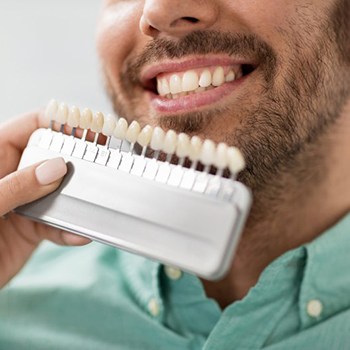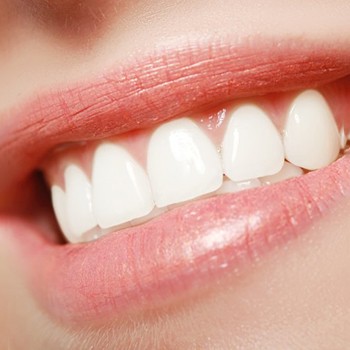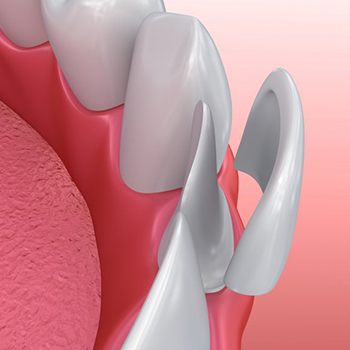Veneers Coppell
Enhance Your Smile by Covering Dental Imperfections
Do you have a chip, stain, crack, or gap in your smile? Instead of settling for a grin that you aren’t comfortable with, you might consider receiving veneers to upgrade your look. These porcelain shells are specifically designed to conceal multiple dental flaws simultaneously by covering the front of your affected teeth. On top of hiding any imperfections in your grin, they can also alter the shape, size, and color of your pearly whites, allowing you to create your dream smile! Keep reading to learn more about this cosmetic dental treatment or give our team a call today to schedule your consultation.
Why Choose Donna L. Kiesel, DDS, PA for Veneers?
- Constructed Out of Dental Porcelain Material
- Personalized Treatment to Fit Your Dental Needs
- Flexible Financing Options Available
What Are Dental Veneers?

Veneers are generally wafer-thin porcelain layers that are meant to be bonded to the front of any teeth that show a mild imperfection, such as stains, chips, cracks, or gaps. This material is typically used because of its durability as well as its ability to mimic natural tooth enamel. Once they’ve been placed, most people won’t even know that you’ve undergone treatment unless you tell them.
The Process of Getting Veneers

It typically takes two visits to complete your veneer process. First, you’ll undergo an initial consultation where we will discuss your oral health and determine if you’re eligible for the treatment. Once we’ve confirmed that you’re free of any underlying issues, we can prepare your affected teeth by altering your tooth enamel to make room for your porcelain shells.
After preparations are complete, our team will take impressions of your smile and send them to a dental lab to begin constructing your veneers. In the meantime, you’ll wear temporary ones to protect your exposed teeth. After your final ones are completed, you’ll return to our office so that we can cement them in place. If all looks well and you’re satisfied with your results, you’ll be free to enjoy your brand-new smile!
The Benefits of Veneers

Some of the biggest advantages of getting veneers include:
- Natural-looking treatment results
- Relatively quick and convenient process
- Improved size, shape, and color of teeth
- Material is resistant to dental staining
- Results can last a decade or more with proper care
Understanding the Cost of Veneers

Since no smile is ever the same, the price of veneers will typically vary from patient to patient. Our team will thoroughly assess your smile and then provide you with an estimate of the cost of treatment. It’s important to remember that dental insurance usually won’t cover cosmetic dental care. That said, our team offers alternative financing options, such as CareCredit, Lending Club, and Submit—third-party financiers that can help break up the price of your care into monthly, low-to-no-interest installments!
Veneers FAQs
Are Veneers Permanent?
Technically, veneers are considered irreversible because they involve a preparatory step that cannot be reversed. For them to fit correctly, Dr. Kiesel must remove a small amount of enamel. Although only about the width of a contact lens is removed, it leaves your teeth somewhat vulnerable to dental problems like tooth decay and gum disease. This protective outer layer doesn’t regenerate so you’ll need to have veneers or another restoration in place to safeguard your smile moving forward.
Furthermore, once your prosthetics are cemented in place, they are not intended to be removed, so many consider them “permanent.”
What Happens to the Teeth Under Veneers?
It’s easy to assume that because your enamel is somewhat thinner, your treated teeth might be damaged while getting veneers. Thankfully, that’s not the case! Only a minimal amount of the hard outer layer is removed. Even better, the porcelain shells are coated with a durable glaze to help them resist chipping and staining, so they shield the underlying tooth once they’re in place.
Veneers aren’t known for causing oral issues, but practicing a diligent at-home dental hygiene routine is essential because cavities and gum disease can cause them to loosen or fall off. You should continue to brush and floss your teeth twice daily but avoid abrasive kinds of toothpaste or alcoholic mouthwashes that can erode the cement holding your prosthetic in place.
Is There Anything I Can’t Eat with Veneers?
After preparing your teeth and making impressions, we’ll send that information to a dental laboratory to build your permanent veneers. Then, to protect your teeth in the meantime, we’ll fit you with a temporary set. These aren’t intended to be worn for very long so they’re not as resilient. You should avoid anything overly hard or sticky that could push or pull them out of place or injure the surface.
Your permanent restorations will be much more resilient, resulting in fewer dietary restrictions. However, overly hard or dark foods could chip or stain them, so steer clear of ice, hard candies, coffee, tea, berries, and other darkly pigmented ingredients.
Do Veneers Give You a Lisp?
Many patients experience temporary changes to their speech patterns once their permanent veneers are bonded in place. Although they’re quite thin, they do add an extra layer to the surface of your teeth, which can make once-familiar movements feel awkward or strange. You might develop a lisp when trying to pronounce certain sounds, like “s,” “v,” or “th.”
Thankfully, these issues typically resolve as your tongue and other supporting muscles in your mouth become accustomed to your restorations. Please let us know if you continue to struggle for more than a couple of weeks. Sometimes, we can thin your veneers slightly to remove the impediment to your pronunciation.
